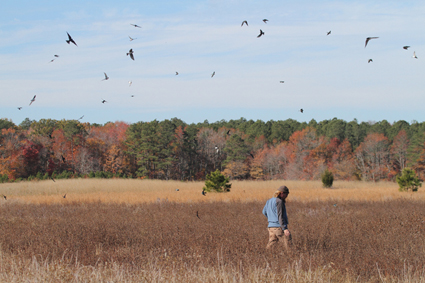Want to Help?
Maryland Biodiversity Project will only reach its full potential with support from the many exceptional naturalists and nature-lovers in our area. Here's how you can help!
Enjoy the site and learn more about nature!
First and foremost, this site is a powerful tool for learning about Maryland nature. We're confident that the more you learn, the more you will want to celebrate and protect Maryland's living things.
Tell people about the project!
The more people involved, the more good the project can ultimately do.
-
Main sitehttps://www.marylandbiodiversity.com/
-
Read our daily Maryland nature posts on Facebookhttps://www.facebook.com/MarylandBiodiversity/
-
Share photos via iNaturalisthttps://www.inaturalist.org/projects/maryland-biodiversity-project/
Be involved on MBP social media
We want to help build an enthusiastic general nature study community. Please "like", "comment", and "share" regularly on Facebook to get more people involved. There are a lot of people excited about learning new types of plants, animals, and fungi. Positive feedback and words of encouragement will go a long way. For Facebook users, please consider hovering over the "Liked" button and selecting "Get Notifications" and/or "Show in News Feed". This ensures that Facebook remembers to show you all our posts. Words of encouragement are especially valuable for our partners in education, such as Jemicy School. Positive feedback there will mean a great deal to the young naturalists that are getting involved! You can find all Jemicy School photos at http://www.flickr.com/photos/90985998@N05/tags/jemicy/ or all education photos at http://www.flickr.com/photos/90985998@N05/tags/education/
Share photos
Sharing photos is a great way to contribute. Even a cellphone photo of a moth under your porchlight or a weed in your yard can addd a new county record to the project. See our FAQ page on how to share photos or read about what kinds of photos we want. You might also check out other ways to help when submitting photos. All photos used will display full credit and a very obvious link to your web site. The Community page lists all contributing photographers, their web sites, and the number of records with their photos. Maryland photos get preferential treatment, but we will use photos from the wildlands surrounding us to ensure we build a full collection.
Collect data
While you're out in the field, photograph what you see and help us gather records. If you concentrate on plants and insects, it's still easy to find new records for any county! If you're feeling extra motivated, use the county record views to see where we need the most help. Which county needs the most easy tree records? Moths? Freshwater fish?

A Maryland naturalist among Biodiversity
Mine data
Are you sick like us? Do you consider working with nature data in Excel to be a form of recreation? If so, please get in touch about helping us mine useful papers for species lists and Maryland records. If interested, we will provide papers from the top of our wish-list, as well as templates to fill in that will allow us to ingest the data. This item requires attention to detail and a basic understanding of spreadsheets. Seriously interest only, please. It takes time to get someone up to speed, so if you are only looking to spend an hour or two, it isn't worth the investment in on-the-job training!
Quality control
Are you an expert on planthoppers? Ferns? Please review our checklists and photos. If something is mis-labeled, if the taxonomy has changed, if anything is out of order, please let us know! If data integrity interests you, let us know if you would be willing to spot-check data mined papers before we ingest it.
Maryland Biodiversity Project is a 501(c)3 non-profit and uses donations to fund professional web hosting, support outreach efforts, provide logistics for major BioBlitz events, and more. We're hoping to raise enough money to cover interns in 2016, which would be a major turbo-boost for the project. You can click the "Donate" button in the top-right corner of any page. If you don't want to use PayPal, feel free to contact us directly at the e-mails below. Thank you!
Support local and regional conservation efforts
Consider donating to American Bird Conservancy, the Maryland/DC Important Bird Area (IBA) program, Bat Conservation International, The Nature Conservancy, or any of the many excellent groups working in our area. Consider being more actively involved with local issues and attending a public hearing. Our collective top priority has to be ensuring all of the species cataloged on this site are still here for generations to come.